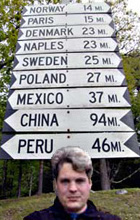Subscribe to the blog 
|
 |
 |
 |
 |
 |
Find a Flight Consider a Consolidator Rent a Car Pick a Railpass Book a Vacation Reserve a Room Get Gear |
|
||||||
|
People
Who Live on Glass Islands Just about every day I was in Venice, we had Acque Alte. That's when the lagoon backwashes into the city streets, starting with Piazza San Marco (the lowest point of Venice) and then filling in the low-lying calle around the Grand Canal. The air raid sirens go off when the rising waters cause the first gondola moored at Piazzetta San Marco to start nudging over the embankment, usually somewhere around 5 a.m. Since this is an ancient and oft-repeated emergency, the Venetians are perennially prepared during the autumnal Acque Alte season. Along key arteries of the city they string out a raised wood-plank walkway in long lines of picnic table–looking devices that allow pedestrians to glide over the surface of the water. Once the waters recede, these wide walkways on their stubby aluminum tube legs are stranded high and dry, dividing the streets down the middle, looking sort of like Venice is about to throw a huge outdoor feast for an army of dwarves. Since my hotel—the lovely Ai Do Mori, ludicrously cheap for its prime location—was a half block off the piazza, my calle was one of the first to go under. I handled this on the first morning, when I had an early appointment to meet with some friends at the Rialto Bridge, by putting two freezer-size Ziploc baggies over my shoes and sloshing out to the plank walkways on the main drag. The other mornings, I solved the problem merely by sleeping in until 10 or 11 a.m., by which time the impromptu canal under my bedroom window was reduced to a shallow puddle I could easily wade through. Sunday morning was memorable, however (for more than I knew, as it later turned out, as more than a third of the city was inundated with 1.21 meters of water, the most water Venice had seen invade its streets in well over a year). I awoke for the second time that day at 8 a.m., having already gotten the early alarm call at 5 a.m. by the acque alte siren. For a few minutes I lay in bed listening for the telltale "sloosh, sloosh, sloosh" of pedestrians four stories below my room going about their business in hip boots or gators. I glanced over at the window to see if the sky was still cloudy (as it had been almost every day save one since I got here), or if it had by some miracle turned blue. What it was, was snowy. This it turns out, is highly unusual, as was explained to me by just about every Venetian I met for the rest of the day, each of whom apologized profusely for the triple whammie of freezing rain and snow, bone-chilling winds, and acqua alta. "This never happens!" they'd cry in dismay, clearly trying to convince me to give their hotels good reviews and not scare tourists away with my tales of Venetian meteorological misery. As it happens, after an entire (late) morning and early afternoon of trudging through this singularly miserable weather, touring hotels and visiting freezerlike churches, I was damp and frozen to the bone and ended up carrying a nasty, flulike cold with me for the next week across the Veneto. But I get ahead of myself. This particular Sunday also happened to be the Festa of Santa Maria della Salute, the plague-halting Madonna to whom is dedicated that gargantuan late-Renaissance church perched at the tip of Dorsoduro (across the Grand Canal from San Marco). For the occasion, they build a temporary floating bridge across the Grand Canal that stays in place for only that week. (Usually there are but three bridges along the entire, lengthy, lazy-S route of the canal: at the train station, the Rialto, and the Accademia). On November 21 — which by ecclesiastical coincidence fell on a Sunday this year — the normally closed grand central doors of the church are thrown open. more >> |

